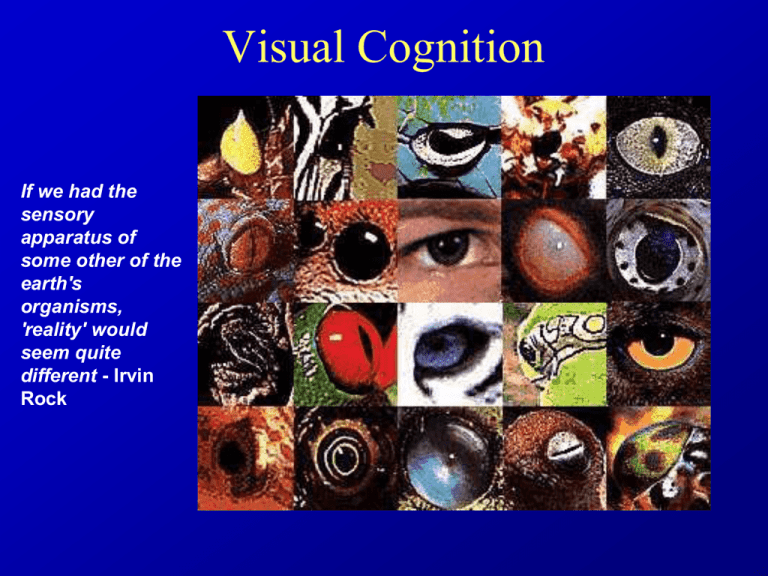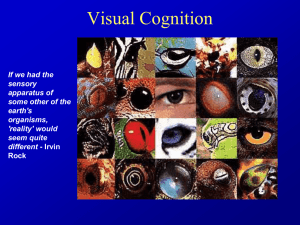Rods & Cones
advertisement

Visual Cognition If we had the sensory apparatus of some other of the earth's organisms, 'reality' would seem quite different - Irvin Rock Visual Cognition: In Humans Camera eye Compound eye The Problem • How to turn an upside down, 2D, warped mirror-reflection and turn it into a right-side up, straightened, aligned 3D world? Sensitivity to Light Across Biological Organisms • Birds have the highest resolution of visual acuity, with cones eight times smaller than ours. • Basic feature design for predators (cats): Both eyes in front • Prey (rabbits, horses): eyes on the sides of the head Sensitivity to Light Across Biological Organisms • Rattlesnakes detect in infrared; • bees detect ultraviolet light. “Function Follows Form” • Two visual systems with(mostly) distinct: – – – – – – photoreceptors regions of the eye Perceptual characteristics (acuity v. sensitivity) Convergence ratio neural pathways target regions Two Photoreceptors: Rods & Cones • Rods – Less dense – Sensitive: brightness, movement • Cones – Dense – Sensitive: acuity / edges, color • Trade-off of Sensitivity for Acuity • The Purkinge Shift Regions of the Eye Retina: Whole inner eye containing all photoreceptor cells. • Fovea indentation on retina, mostly Cones. – fine discrimination; colors & detail. • Periphery area outside fovea, mostly rods – Sensitivity to brightness, movement – Optic disk: “Design Flaw” place where axons exit eye forming optic nerve. Rods & Cones: Regions of the Eye & Convergence Ratio Cones-specialized for color vision & detail fovea. Rods-sensitive to light periphery • 126 million receptors total with 6 million cones. • Cones = 5% of photoreceptors, but 25% of brain dedicated to them. Specialization of light processing determined by convergence ratio. Rods-big receptive fields Cones-small receptive fields How Does Visual Information Flow? • Lateral Inhibition Information Flow: Lateral Inhibition • Mach Bands Luminance Comparison Both squares are identical in luminance gradient. The four squares are identical in luminance gradient. Portions indicated by arrows have the same mean luminance. Rods & Cones: Convergence Ratio Specialization of light processing determined by “convergence ratio.” Many rods converge on a single retinal ganglion = Sensitivity Few Cones converge on a single retinal ganglion = acuity (detail) Rods-big receptive fields cones-small receptive fields What is a receptive field of retinal ganglion cells? Kuffler (1953) presented spots of light to retina cells in the cat & recorded their responses. • The cells have a Concentric circle configuration! • usually called center-surround cells • On-center, off-surround cell has an “excitatory center,” & “inhibitory surround” • Off-center, on-surround cell has an “inhibitory center” & “excitatory surround” Information Flow: Receptive Fields Edges and Receptive fields Receptive fields at work. Receptive fields at work. As your fovea lands on a white intersection, the black corners of the neighboring squares fall on the retina, with its larger receptive fields. With each of the four corners falling into a receptive field, the receptive field sums to ‘dark’. How the Hermann Grid Illusion Works • (from a student response) The retina contains collections of photoreceptors, some of which are activated by light and others which are activated in the absence of light. The two types are usually arranged to encircle each other, dark ones around light ones and vice versa, and are spread throughout the retina. The gray spots appear in the intersection of the grid due to the competing effects of the dark and light photoreceptors. • When looking at the grid as a whole, the majority of which is dark, it causes the more numerous dark photo receptors to activate, overiding the light activated ones, and causing a subtle darkening effect. When you focus directly on the white space at the intersections between the squares, it narrows the field of vision, with the smaller resulting receptive fields able to “fit” within allowing the light detecting photoreceptors to function without interference from the dark activated ones. Receptive fields in Art Mona Lisa’s beguiling smile results from the large receptive fields signaling darkness at the corner of her mouth, drawing your attention, directing your eye to foveate on the corner. The fovea has smaller receptive fields, which do not sum with darkness, making the smile look like it is disappearing. Apparent movement of the streams is created by afterimages as our eyes shift to examine the picture. Two Visual Systems • Geniculostriate & Tectopulvinar Visual Pathways • 1. Geniculostriate pathway– optic chiasm LGN Primary Visual Cortex Ventral “What” – Signals from fovea & cones (mostly); Parvo – involved in patter perception, color vision • 2. Tectopulvinar pathway– optic chiasm---superior colliculus---Lateral Posterior Pulvinar-- Visual Cortex Dorsal “Where/How”; Magno – Signals from periphery & rods (mostly) – detection of light; spatial orientation Information Flow Optic Chiasm Retinal- Lateral Calcarine Geniculate pathway Nucleus Dorsal Pathway Parvocellular Retina (rods & cones) Magnocellular Visual Cortex 1 (V1) Tectal Pathway Superior Colliculus Ventral Pathway Parvo and Magno Cellular Pathways: Example of Double Dissociation • Lesions to the parvo-cellular pathway affect perception for color, and fine detail (small spatial frequencies); Lesions to magno-cellular pathway do not. • Lesions to magno-cellular pathway affect perception of movement, brightness contrast (flicker); Lesions to parvo-cellular pathway do not • An engineer’s box diagram of the neural circuitry in visual perception, from the retina to the hippocampus. Information Flow • Topographic Information Flow • Visual Hemifields measurement • cones: vision under bright illumination – Cone time constant=100ms, 1,000 photons can be presented in a brief period (say, 1000 photons within a 1 ms period) or over a long period (such as 200 photons in each of five 20 ms period) for the same visual effect. The cones cannot tell the difference. – Rod time constant=400 ms, meaning the photon catch extends over a longer time interval working like a slow shutter speed on a camera (well, cameras once had shutters that had a “click” that digital cameras artificially reproduce even though there is nothing to “click” any more.) Sensation vs Perception • The difference between sensation and perception is the difference between light and color • It requires senses to detect light • It requires perception and cognition to see color • Color happens both in the eye and in the brain Measurement in Vision Science • light measured in nanometers (nm) nan·o·me·ter (năn'ə-mē'tər) – 1nm=1billionth meter – eyes sense from 360nm to 780nm on the infinite scale of wavelength – nothing. – “light” is whatever energy falls in that range “light” by definition, is anthromorphized. • 1st feature of light – wavelength:480=blue, 540=green, 565=yellow,590=red Electromagnetic Radiation What are the 2 properties of light that influence visual perception? • 1. Wavelength is associated with our perception of color. • 2. Intensity is associated with our perception of “brightness.” Visual Cognition: Describing Light • Hue or Value (Color) • Luminance (Brightness) • Saturation (Purity) We have three cone wavelengths • 1. Short wavelength: peaks at 419 nm (blues). • 2. Medium wavelength: peaks at 531 nm (greens). • 3. Long wavelength: peaks at 558 nm (reds). • The primary colors are blue, green, & red Additive Color mixing with lights Results of Additive Color Mixing Two Theories of Color Cognition • Young-Helmholtz Trichromacy Theory • Proposed in 1802 and confirmed in 1983 – You should be able to create any color by combining three basic colors, red, green and blue. • Evidence: three different colored pigments in the fovea (electron micropscope) Two Theories of Color Cognition Trichromacy does not explain: • Incompatible colors cannot be seen. Why can’t we see certain colors (reddish-green, bluish-yellow) • Color afterimages. Opponent Process We have 3 opposing mechanisms: red-green, yellowblue, & black-white. These are called complimentary colors & put together they produce yellow or white. + Opponent Process in a Movement Illusion: Waterfall Effect • http://video.google.com/videoplay?docid=6294268981850523944&ei=r5P RSNGPD6fcqAPS48y6Ag&q=spiral+visual+illusion&vt=lf&hl=en • http://video.google.com/videoplay?docid=2927422796086500362&vt=lf&hl=en Color Perception • Each set of colored rectangles, against the solid background, is the same • http://www.youtube.com/watch?v=mf5otGNbkuc&feature=em-subs_digest-newavtr-vrecs Assume Surrounding Colors are Constant In this illusion, the second card from the left seems to be a stronger shade of pink in the top picture. In fact they are the same color, but the brain changes its assumption about color due to the color cast of the surrounding photo. Color-blindness • Results whenever we are either missing one of our cones or one of our cones doesn’t work properly. Color Helps To Recognize Objects Color Helps To Recognize Objects Color Helps To Recognize Objects Color Helps To Recognize Objects Color Helps To Recognize Objects






